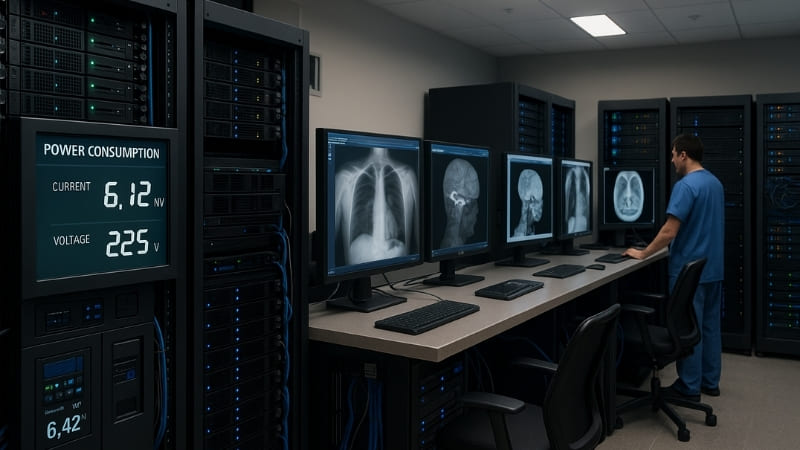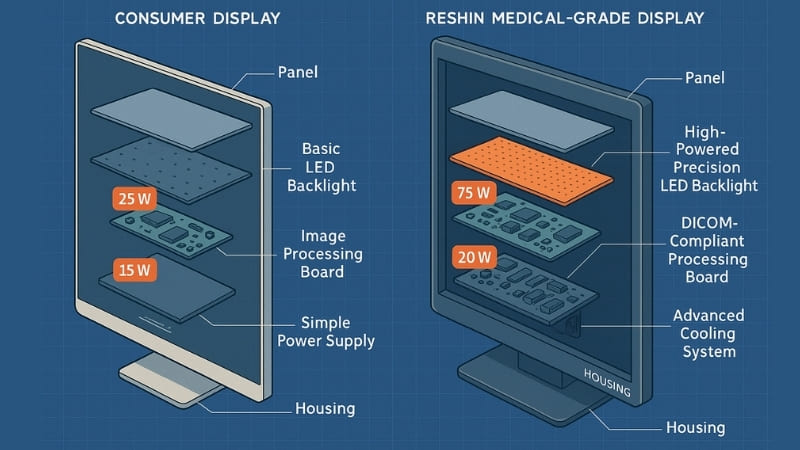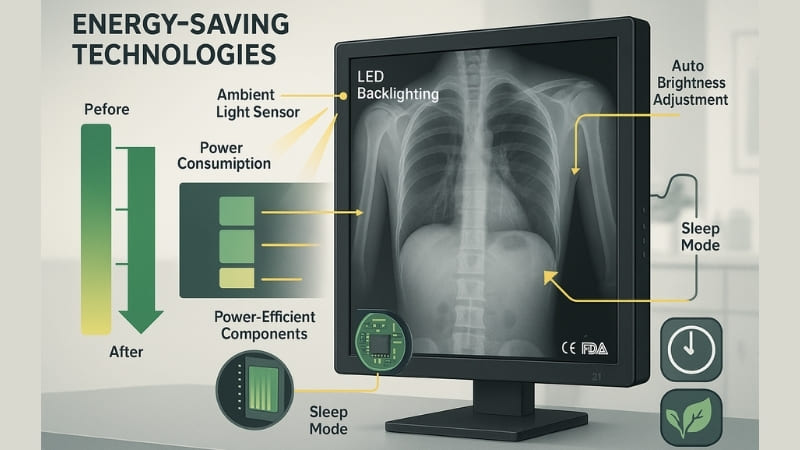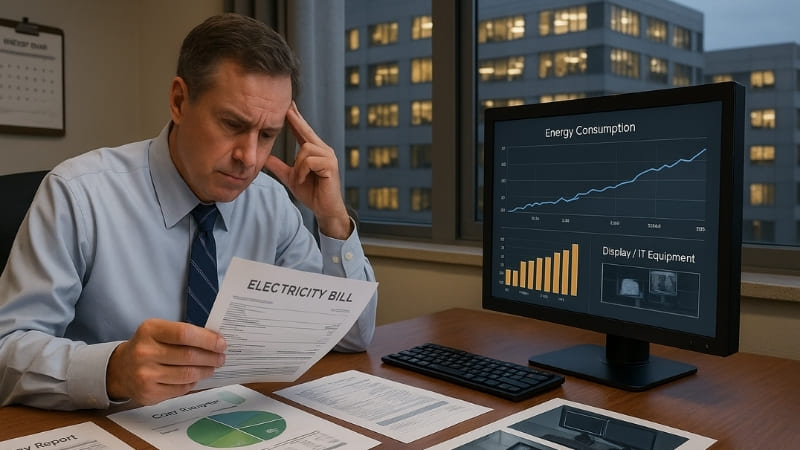Hospitals run on electricity, and every device adds to the bill. Medical displays are essential, but do they drain more power than you think?
Medical-grade displays typically consume more power than standard consumer displays due to their advanced components and performance requirements. This increased consumption, when multiplied across numerous units in a healthcare facility, can significantly impact overall energy usage and operational costs if not managed effectively.

As someone deeply involved in medical display technology at Reshin, I often discuss the total cost of ownership with healthcare providers. Power consumption is a growing part of that conversation. It’s not just about the purchase price; ongoing operational expenses matter greatly.
Many people don’t realize how specialized these displays are, and that specialization sometimes comes with higher energy needs. But it’s also an area where thoughtful design and smart choices can make a real difference. Let’s look at how these essential tools contribute to energy use and what can be done about it.
What are the specific differences in power consumption between medical-grade displays and ordinary displays?
Your home TV and a radiologist’s monitor look similar. But under the hood, they’re very different. Does that difference extend to their power thirst?
Medical-grade displays often consume more power due to higher brightness requirements, complex internal processing for image accuracy (like DICOM compliance), more robust components for stability, and features like integrated sensors. Standard displays prioritize lower cost and general-purpose use.

It’s true that medical-grade displays, especially those used for primary diagnosis in fields like radiology, generally have higher power consumption than the ordinary displays you might find in an office or home. I often compare it to a high-performance car engine. Our Reshin medical displays have higher internal hardware configurations. These are necessary to ensure the extreme display accuracy and stability that doctors rely on. For example, to meet DICOM Part 14 standards, a display needs to maintain very specific, consistent brightness levels, often much higher than a typical office monitor. This sustained high luminance directly translates to more power usage.
Furthermore, the internal electronics are more complex. They handle intricate image processing, store calibration data, and often include self-calibration sensors. These features ensure that the image remains true and consistent over time, which is vital for accurate diagnosis. I remember visiting a hospital’s radiology department where their diagnostic displays operate nearly 24 hours a day. The facilities manager pointed out that the annual electricity bill for just that department’s monitors was significantly higher than for a similar number of displays in their administrative offices. A typical 24-inch office monitor might consume 20-30 watts, while a 3MP diagnostic monochrome display could easily use 60-80 watts or more, especially at peak calibrated brightness. This difference adds up quickly.
Typical Power Consumption Comparison
| Display Type | Typical Size | Approx. Power Consumption (Active) | Key Power Drivers |
|---|---|---|---|
| Standard Office Display | 24-inch | 20-30 Watts | General tasks, lower brightness |
| Consumer UHD/4K Display | 27-inch | 30-50 Watts | Higher resolution, brighter panels |
| Clinical Review Display | 27-inch 2MP | 35-55 Watts | Higher brightness, some DICOM pre-sets |
| Diagnostic Radiology (Mono) | 21-inch 3MP | 60-80+ Watts | Very high sustained brightness, DICOM, stability |
| Surgical Display | 32-inch 4K | 80-150+ Watts | Max brightness in OR, low latency, image processing |
This isn’t about inefficiency; it’s about the power needed for critical performance.
How does the quantity of medical-grade displays in healthcare organizations affect the overall power consumption level?
One display might not seem like much. But hospitals use hundreds, even thousands. How does this sheer volume impact their total energy footprint?
The large number of medical-grade displays used throughout a healthcare organization—from patient rooms to diagnostic suites—means their individual power consumption, even if modest, aggregates into a substantial portion of the facility’s total electricity usage.

The impact of quantity is straightforward but significant. The greater the number of medical-grade displays in a healthcare organization, the higher the total power consumption. It’s just like having more light bulbs in your home; each one adds to the electricity bill. In a modern hospital, these displays are everywhere. You’ll find them at nurses’ stations, in operating rooms, in radiology reading rooms, at patient bedsides, in labs, and in administrative offices. When medical-grade displays, with their typically higher power draw, are installed on each floor and in each department, the total power consumption becomes quite substantial.
I’ve worked with large hospital networks planning major upgrades. During these discussions, we often calculate the potential energy load. For a large hospital with, say, 500 diagnostic and clinical review displays, even an average increase of 20 watts per display compared to standard office monitors can mean an extra 10 kilowatts of constant power demand. Over a year, operating 24/7, that’s over 87,000 kilowatt-hours – a considerable energy and cost figure. This energy consumption from displays alone can account for a noticeable percentage of a hospital’s total energy use, especially for IT and medical equipment categories. It’s a scale issue that facilities managers are increasingly aware of. At Reshin, we understand this, which is why we also focus on energy efficiency in our designs.
Illustrative Annual Energy Impact (Hypothetical)
| Number of Displays | Avg. Power per Display | Hours/Day Operation | Daily kWh | Annual kWh (approx.) |
|---|---|---|---|---|
| 100 | 50 Watts | 16 | 8 kWh | 2,920 kWh |
| 500 | 50 Watts | 16 | 40 kWh | 14,600 kWh |
| 1000 | 50 Watts | 16 | 80 kWh | 29,200 kWh |
| 500 (Radiology 24/7) | 70 Watts | 24 | 84 kWh | 30,660 kWh |
These numbers show how quickly the energy demand escalates with scale.
What energy-saving technologies or measures can medical-grade displays adopt to reduce power consumption in healthcare organizations?
Higher power needs are a reality for medical displays. But are there ways to be smarter about it? Can technology help curb their energy appetite?
Medical-grade displays can incorporate energy-saving features like LED backlighting, ambient light sensors for automatic brightness adjustment, presence sensors for auto-sleep mode, and efficient power supply units. Setting power management policies also helps reduce consumption.

Absolutely, there are ways to make medical-grade displays more energy-efficient. At Reshin, we actively work on this. Efforts can be made in both the hardware design and by encouraging smart usage habits. For instance, the shift from older CCFL (Cold Cathode Fluorescent Lamp) backlights to LED (Light Emitting Diode) backlights in display panels was a huge step. It’s much like changing old incandescent light bulbs in your home to modern LED lights; the energy savings are significant for the same, or even better, light output.
Many modern medical displays, including some of our Reshin models, now incorporate intelligent features. Ambient light sensors can automatically adjust the screen’s brightness based on the room’s lighting conditions. This not only saves energy by not running the display at maximum brightness unnecessarily but also improves viewing comfort for the user. Presence sensors are another great feature; they can detect if a user is in front of the display. If no one is present for a set period, the display can automatically enter a low-power sleep mode or even turn off. This is similar to the auto start-stop function in a modern car, reducing power consumption automatically when the display is not actively in use. Furthermore, designing highly efficient power supply units (PSUs) with minimal energy loss is crucial. Even small savings in power per display, when multiplied by hundreds of units, can lead to significant reductions in a hospital’s overall electricity costs. Some newer technologies even include dynamic refresh rates, which lower power when a static image is shown.
What is the relationship between the power consumption changes of medical-grade displays and the operating costs of healthcare organizations?
Electricity isn’t free, especially for large hospitals. How directly does the energy use of their many screens hit the bottom line?
The power consumption of medical-grade displays directly translates into electricity costs, forming a tangible part of a healthcare organization’s operating expenses. Higher energy use means higher bills, impacting budgets that could otherwise fund patient care or other essential services.

The relationship is very direct: the power consumption of medical-grade displays directly impacts a hospital’s operating costs. Electricity is a major utility expense for any large institution, and healthcare facilities are no exception, especially with their 24/7 operations and energy-intensive equipment. Every watt consumed by a display contributes to the overall electricity bill. When you have hundreds or thousands of displays, even small differences in power consumption per unit can lead to substantial variations in annual energy expenses. High energy consumption inevitably means increased electricity bills.
I’ve seen financial controllers in hospitals scrutinize these costs closely. In some cases, these increased operational expenses might indirectly put pressure on other budget areas or, in a broader economic sense, contribute to the overall cost of healthcare delivery, which could eventually be passed on to patients in the form of higher medical fees or insurance premiums. Therefore, hospitals are increasingly looking to balance the need for high-quality diagnostic displays with the imperative to manage energy consumption effectively. The electricity costs saved by choosing more energy-efficient displays or implementing better power management strategies can be significant. These savings can then be allocated to other pressing needs, such as new medical equipment, staff training, or patient care initiatives. It’s a practical aspect of modern healthcare management that we at Reshin take seriously when designing our products.
Conclusion
Medical displays impact hospital power use. While essential, their energy footprint affects costs. Choosing efficient models and smart features helps manage this vital operational expense effectively.


